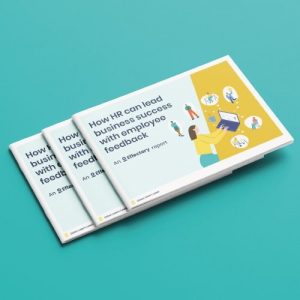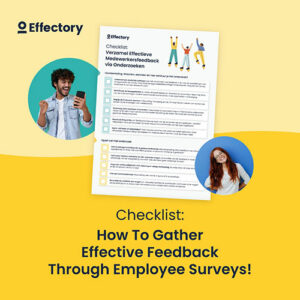In partnership with HRD Connect, Effectory recently co-hosted an expert Roundtable. Myself, Arjen Swank, an Employee Engagement & Research Specialist here at Effectory, was joined by the moderator, Martijn Seijsener, Global Head of Employee Experience at Credit Suisse.
Establishing a winning end-to-end employee listening strategy

Why an ‘end-to-end’ listening strategy?
Without an effective employee listening strategy, HR and business leaders cannot truly connect with their workforce or understand them as critical assets to the business.
When a workforce isn’t heard, it negatively impacts engagement, which can have a lasting effect on customer experience and business success. Employee listening must now be continuous, from the point of hire to exit interview, if it’s going to support wider business goals and earn your organization employer branding via word-of-mouth recommendations.
How do you implement a holistic employee listening strategy that works for you and your employees?
The aim of this session was to understand how HR can accurately capture the employee experience to make strategic changes that feed a supportive and productive organizational culture.
We discussed:
- What a good end-to-end employee listening strategy looks like, and its role in feeding employee experience and engagement
- How to identify and take strategic insights from employee listening feedback
- How to use data & analytics highlighted through employee listening to implement change into business strategy
- What’s the role of technology in end-to-end employee listening strategies?
The following is taken from the session, though contributions have been anonymized.
Learn to really hear your people
When creating a listening strategy, HR must first understand how to really listen to their people if they are to understand what they want and what they need. The next step is for HR to then convert that data into actionable insights.
If you listen to people you have an obligation to go back to them quite quickly to show them what you’ve been doing with that feedback.
The discussion began with all participants outlining the challenges they have faced when creating their employee listening strategy.
Book a free demo. See our solutions in action.
Effectory is Europe’s Leading provider of Employee Listening Solutions. Schedule a product demo and discover how to enhance your employees’ engagement.
Demo requestWhat are some of the obstacles to accessing employee feedback?
One key challenge identified by the panel was the gap between collecting organic feedback from employees versus at a point in time.
In regards to employees, there is a concern from HR for survey fatigue – when employees don’t see the value in or get bored supplying their feedback, and so stop doing. Additionally, it was noted how external factors such as salary reviews can affect the results.
Solutions to gathering employee feedback more organically was a focus on manager training. Good relationships between managers and their teams is a great way for people to open up and share their thoughts.
Another method for gaining organic feedback is by opening a workplace chatroom. One individual on the panel shared that this had worked well at their organization, as the platform allowed for organic topic creation without a facilitated session by a line manager or HR.
However, the negative side of this is the risk of disagreement and the conversation quickly getting out of hand.
How HR can lead business success
HR and employee listening are crucial to business success. Here is how employee insights can help your organization.
DownloadA case study in survey ambassadors
One solution that came up as an example was a company-wide initiative – already in motion – around the value of an ambassador network.
Associates were asked to volunteer to be ambassadors, intermediaries between all associates and the organization’s leadership team. In this initiative, ambassadors hold confidential conversations with associates and gathered input, making a note of the key themes arising during discussions.
Some themes have been easy to navigate, while other themes are bigger in nature, such as company culture. For tacking the larger themes, ambassadors work with senior managers who are brought in to guide the conversations. An HR lead manages the overall discussion.
So far, associates have been very happy with the opportunity to open up and express themselves outside of an annual survey. However, capturing employee voice throughout the year on more neutral terrain can be tricky, particularly with larger organizations who want to scale this over time.
We asked all the panel’s attendees if they feel they have sufficient insights into the needs of their employees during the employee lifecycle to build a future-proof organization. This is what they said:
- 50% – Yes, I have a bit of insight
- 30% – I’m not sure
- 20% – No, none at all
Getting deep insights at different moments of the employee journey
Most organizations on the panel use an external party to create their employee engagement strategy. The challenge with that is to connect the data with that they already have.
For some, the ultimate outcome would be being able to collect all data from all surveys – from onboarding to exit interviews – then move forward with more of a holistic vision.
We asked if employees know when they’ll be asked for feedback. For one individual, the answer was no. Generally speaking for them, surveys are performed ad-hoc to enable HR to gather themes as and when they are relevant. The next initiative for them would be to think proactively about their survey strategy, and give employees forewarning about when the next survey(s) will run.
Approaches to performing engaging employee surveys
Another organization had a clearer employee lifecycle listening strategy. They run a census survey annually, alongside smaller pulse surveys at specific points in time. These smaller surveys are not sent to every employee, but instead to selected employees. This is to avoid survey fatigue.
There was a HR professional from a larger organization on the panel, who said that because a large percentage of its workforce are deskless, gathering feedback requires a different approach. This organization runs an annual census survey and ask workers to come into the office when HR have set up kiosks for employees to go in and submit feedback via laptops.
For those unable to access the office, surveys can be accessed via QR codes. It was also mentioned that on the day of the survey, there are other things going on such as learning opportunities, so that employees don’t have to come in just to submit feedback. This encourages everyone to go into the office, making it a more interactive and useful experience. According to this participant, this method has thus far been successful, and they experience great response rates.
How to gather feedback from your employees
The definitive checklist for creating your employee engagement survey.
DownloadFinally, another organization of over 2,000 people had a very different approach to share. Instead of an annual survey, they do monthly pulse surveys. Each survey gets around a 35% response rate, which equates to one individual completing a survey every three months. Each survey also gets over 200 comments, so it’s clear that people are engaging.
HR commits to responding to each comment within a two week time frame. Managers are also responsible for responding, and have access to their own dashboard of feedback for their team. HR and executive leadership see an organization-wide dashboard, so that they can quickly enact responses.
Closing feedback loops and next steps
Closing the feedback cycle isn’t exclusively about giving it back to management or executive leadership. Closing the feedback loop is also about giving back to people.
A company must have a human centric approach, starting with the needs of their people before developing a solution, product or service. This is now something that isn’t just a nice-to-have, it’s a need-to-have.
In a show of hands, around 50% of the panel voted in preference of HR providing employees with a dashboard of survey results directly.
When asked to expand on this preference, one individual noted that they share the dashboard but not the comments to open questions.
When discussing next steps and measures taken following feedback results, one organization mentioned that they hold “best practice” sharing sessions, where leaders with varying feedback results can share knowledge and tips.
Book a free demo. See our solutions in action.
Effectory is Europe’s Leading provider of Employee Listening Solutions. Schedule a product demo and discover how to enhance your employees’ engagement.
Demo request

